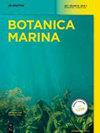墨西哥Veracruz的Gelidiella papillosa sp. 11 . (Gelidiellaceae, rhodophya),在全球分布的背景下
IF 1.4
4区 生物学
Q2 MARINE & FRESHWATER BIOLOGY
引用次数: 0
摘要
摘要/ Abstract摘要:尖角Gelidiella acerosa是一种在也门广泛分布的物种,其形态特征为横卧轴,其中有许多丰富的分支直立轴,有果枝状的,有互生的或径向的。最近的系统发育研究揭示了在其分布范围内存在遗传上独立的群体。然而,这些类群不能被描述为独立的,因为没有来自类型局部性的序列,使我们能够建立真正的刺荆芥所属的遗传类群,产生了一个隐物种的复合物。在本研究中,从COI-5P和rbc L序列数据中,我们检测到6个遗传分化群体,其中一个仅在西大西洋地区的标本中有代表。考虑到这种异域分布模式,有可能将大西洋群描述为印度-太平洋神秘复合体的一个独立物种。Gelidiella papillosa sp. 11 .与其他国家以前鉴定为G. acerosa的标本有几个形态学特征,如菌体的外观,分支模式,分支上存在多根表面毛或细胞测量。然而,这些性状在不同遗传群间还没有得到详细的评价,因此只能从其遗传独立性和异源分布来支持。本文章由计算机程序翻译,如有差异,请以英文原文为准。
Gelidiella papillosa sp. nov. (Gelidiellaceae, Rhodophyta) from Veracruz, Mexico, in the context of the worldwide distribution of G. acerosa
Abstract Gelidiella acerosa is a widely distributed species, with type locality in Yemen, whose morphology has been characterized by decumbent axes from which numerous abundantly branched erect axes emerge, pectinate, alternate or radial. Recent phylogenetic studies have revealed the presence of genetically independent groups throughout its distribution range. However, these groups cannot be described as independent since there are no sequences from the type locality that allow us to establish the genetic group to which the true G. acerosa belongs, generating a complex of cryptic species. In the present study, from COI-5P and rbc L sequence data, we detected six genetically differentiated groups, one of which is represented only by specimens from the Western Atlantic region. Given the allopatric pattern, it is possible to describe the Atlantic group as an independent species of the cryptic complex in the Indo-Pacific. Gelidiella papillosa sp. nov. shares several morphological features with other specimens previously identified as G. acerosa in other countries, like the appearance of the thallus, branching patterns, the presence of multiple superficial hairs on the branches or cell measurements. However, these characters have not been evaluated in detail among the different genetic groups within Gelidiella acerosa , consequently, G. papillosa can be supported only by its genetic independence and allopatric distribution.
求助全文
通过发布文献求助,成功后即可免费获取论文全文。
去求助
来源期刊

Botanica Marina
生物-海洋与淡水生物学
CiteScore
4.10
自引率
4.50%
发文量
43
期刊介绍:
Botanica Marina publishes high-quality contributions from all of the disciplines of marine botany at all levels of biological organisation from subcellular to ecosystem: chemistry and applications, genomics, physiology and ecology, phylogeny and biogeography. Research involving global or interdisciplinary interest is especially welcome. Applied science papers are appreciated, particularly when they illustrate the application of emerging conceptual issues or promote developing technologies. The journal invites state-of-the art reviews dealing with recent developments in marine botany.
 求助内容:
求助内容: 应助结果提醒方式:
应助结果提醒方式:


